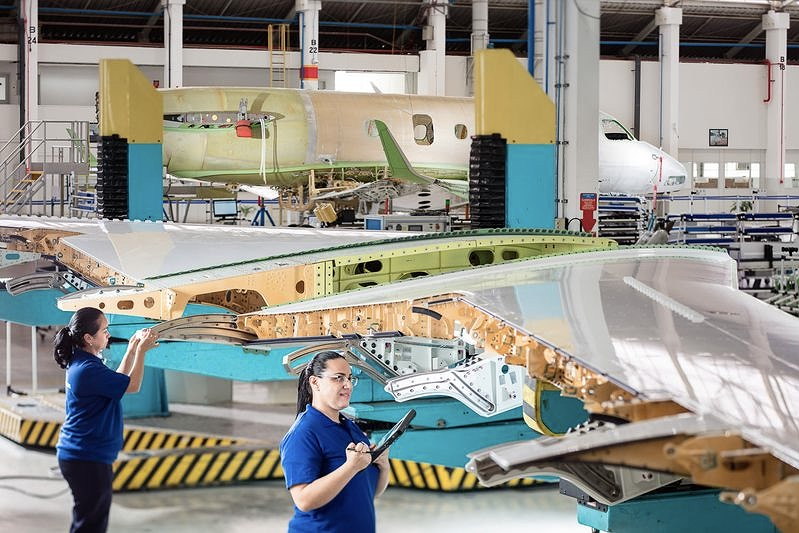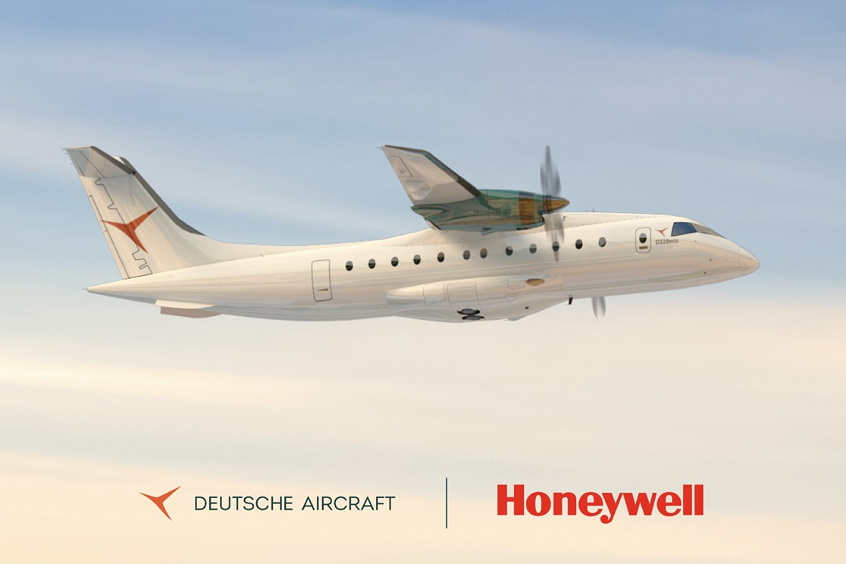On 7 July 2009, Antares DLR-H2, the world's first piloted aircraft capable of taking off using only power from fuel cells, demonstrated this capability at Hamburg Airport. Antares DLR-H2 has been developed by the German Aerospace Center (Deutsches Zentrum fuer Luft- und Raumfahrt; DLR). The Antares flies with zero CO2 emissions and has a much lower noise footprint than other, comparable, motor gliders. The propulsion system for this aircraft was developed at the DLR Institute for Technical Thermodynamics (Institut fuer Technische Thermodynamik – Stuttgart) in collaboration with its project partners – Lange Aviation, BASF Fuel Cells and Serenergy (Denmark). This motor glider achieves new quality standards in the field of high-efficiency, zero-emission energy conversion and clearly demonstrates the progress that has been made in fuel cell technology.
The centrepiece and greatest innovation on the Antares DLR-H2 is the fact that it is powered directly by means of an ultra-efficient fuel cell. "We have improved the performance capabilities and efficiency of the fuel cell to such an extent that a piloted aircraft is now able to take off using it," stated Prof. Dr-Ing Johann-Dietrich Woerner, Chairman of the Executive Board at DLR. "This enables us to demonstrate the true potential of this technology, also and perhaps specifically for applications in the aerospace sector. Coupled with our expertise in fuel cell technology, DLR's many years of extensive experience in gaining official approval for aerospace systems are what made the Antares DLR-H2 a feasible proposition."
Standard motor glider retrofitted with fuel cell drive
The Antares DLR-H2 is based on the Antares 20E motor glider with a wingspan of 20 metres, constructed by Lange Aviation, a company based in the Rhineland-Palatinate region of Germany. With its fuel cell propulsion system, Antares has a cruising range of 750 kilometres, achieved in a flying time of five hours. In order to accommodate the fuel cell and the hydrogen supply on board the aircraft, two additional external load carriers were slung under the specially reinforced wings. Due to the extra 100 kilograms of payload that each of these removable and flexibly interchangeable containers is able to carry, the aeroelastic properties of the wings had to be reconfigured to prevent any adverse impact on the flight stability of the aircraft. Optimisation work at the DLR Institute for Aeroelasticity (Institut fuer Aeroelastik – Goettingen) now provides the Antares DLR-H2 with an assured capability to fly at speeds of up to 300 kilometres per hour without any wing flutter. The current propulsion system permits maximum flying speeds of approximately 170 kilometres per hour.
A fuel cell system is the centrepiece of propulsion technology
The fuel cell system was developed by the DLR Institute for Technical Thermodynamics in collaboration with BASF Fuel Cells (electrolytic membrane and catalysts) and Serenergy A/S (stack subsystem). The system uses hydrogen as its fuel, and this is converted into electrical energy in a direct, electrochemical reaction with oxygen in the ambient air, without any combustion occurring. During this zero-particulate reaction, the only by-product is water. If the hydrogen fuel is produced using renewable energy sources, then the motor glider genuinely flies without any CO2 emissions whatsoever. The fuel cell is slung under the left wing and the hydrogen tank under the right wing – with a capacity of either 2 or 4.9 kilograms. The fuel cell system used to power the Antares delivers up to 25 kilowatts of electrical power. When flying in a straight line, the aircraft only requires about ten kilowatts of power. In this situation, the fuel cell is operating at an efficiency level of approximately 52 percent.
The total efficiency of the drive system from tank to powertrain, including the propeller, is in the region of 44 percent, making it about twice as efficient as conventional propulsion technologies based on combustion processes. Systems powered by kerosene or diesel only contribute about 18 to 25 percent of their energy to propulsion.
"The top priority in this project is of course the safety and reliability of the fuel cell propulsion system," stated Antares Project Manager Dr-Ing. Josef Kallo from the DLR Institute for Technical Thermodynamics. However, having the correct architecture for the entire system is just as important for full implementation of this project: "This includes having an absolutely reliable fuel cell, in conjunction with propulsion system of the aircraft and, last but not least, a fully mature configuration for the aerodynamics and aeroelasticity of the motor glider."
Another new feature of the Antares is the way its fuel cell is connected to the main electric motor that powers the aircraft. The motor controller, developed jointly with Lange Aviation and with the College of Advanced Technology in Berne/Biel, is capable of taking in and controlling voltages from 188 to 400 V. Through the direct link between fuel cell and motor, efficiency, costs, reliability and maintenance costs are minimised.
Fuel cell as future energy source for air transport
"With our successful first flight, we have verified the feasibility of fuel-cell powered flight and our next steps will focus on improving efficiency levels and on extending the service life of these systems", stated Dr Kallo. This could, for example, make it possible to significantly improve performance by optimising the cooling concepts, fuel cell architecture and components such as the air supply system. "At this stage, we have only tapped into a fraction of the performance capabilities of this technology for aerospace applications. The Antares DLR-H2 will help us to make much greater use of these areas of potential."
Although the fuel cell may still be a long way from becoming the primary energy source for the propulsion of commercial aircraft, it does already constitute an interesting and important alternative to existing energy systems as a form of reliable on-board power supply. High efficiency levels go hand in hand with minimum pollutant emissions, lower noise levels, safe flying operations and high standards of passenger comfort. The aim of the research work being conducted by DLR is to employ fuel cells in real-life applications for commercial air transport – as a reliable supply source for on-board power. In an initial stage of development, DLR collaborated with Airbus Germany on a fuel cell system for providing an emergency power supply to the hydraulic pumps used to control the DLR research aircraft - the Airbus A320 ATRA. In a second step, the ongoing use of a fuel cell system to provide an on-board supply in large-volume transport aircraft is firmly on the drawing board. In future, the Antares DLR-H2 motor glider will provide a cost-effective platform for testing fuel cell systems for aerospace. Among other things, this optimises the test time of the DLR Airbus A320 ATRA.
Flying test laboratory will in future be teaming up with the Fuel Cell Lab in Hamburg
The Antares DLR-H2 will be based at Lufthansa Technik in Hamburg where, over the next three years, it will be acting as a flying test platform for the fuel cell test activities of DLR as part of its Fuel Cell Labs project. The Fuel Cell Lab was brought into being by the City of Hamburg on a joint basis with DLR and Airbus/EADS and is intended to 'bundle' a high proportion of the hydrogen and fuel cell activities being conducted in the greater Hamburg region. By stationing this research aircraft on the premises of Lufthansa Technik, direct contact can be established with an experienced technical development and maintenance operation in the air transport business. This linkage will also help to enhance the ease of operation and maintenance of the future fuel cell systems designed for use in large-volume air transport and developed by DLR in its capacity as a development partner for Airbus. To safeguard and further develop the level all-round flying expertise for this new fuel cell application, DLR and Lange Aviation GmbH have co-signed a cooperation agreement. Other partners who have already joined include BASF Fuel Cell GmbH, Serenergy A/S and Lufthansa-Technik AG, who came on board in the course of 2008.
| Contact details from our directory: | |
| BASF New Business GmbH | Fuel Cells, Generating Systems, Electrical Wire & Cable, Superconducting Materials |
| DLR - German Aerospace Center | Fuel Cells, Testing Services, Research/Consulting Services, Composite Design Consultants, Flight Simulators, Instrument Landing Systems, Prototyping, Airframer, Vibration Testing |
| Related directory sectors: |
| Test Services |
| Design |
Weekly news by email:
See the latest Bulletin, and sign up free‑of‑charge for future editions.
IAI North America selects three startups for accelerator program

Embraer launches program for supply chain efficiency

Honeywell's HF radio system earns a place aboard the D328eco
GE Aerospace demonstrates hybrid electric propulsion for U.S. Army